[dropcap]While[/dropcap] many people may think of handcrafted mixed drinks as being the domain of bars in New York or Los Angeles or restricted to stuffy rooms, the cocktail scene is alive and growing in Oklahoma. We talked to four bartenders about the newest trends in drinks, how they got into the business and what they love about bringing the craft of cocktails to customers.
A Heck of a Party in OKC
You might not expect to find Anna Mains, the co-owner of Rockford Cocktail Den, DEKORA! and Knucks Wheelhouse, behind the bar that often. Far from being more work, however, her shifts behind the bar serve as a retreat.
“There’s something invigorating about working behind the bar,” she says. “I have had days where I am in hands-down the worst mood, stressed beyond any sort of stress I ever thought I could handle, and the moment I walk behind the bar and I start making drinks and I start interacting with guests and I see people having a good time, my mood is always completely transformed.”
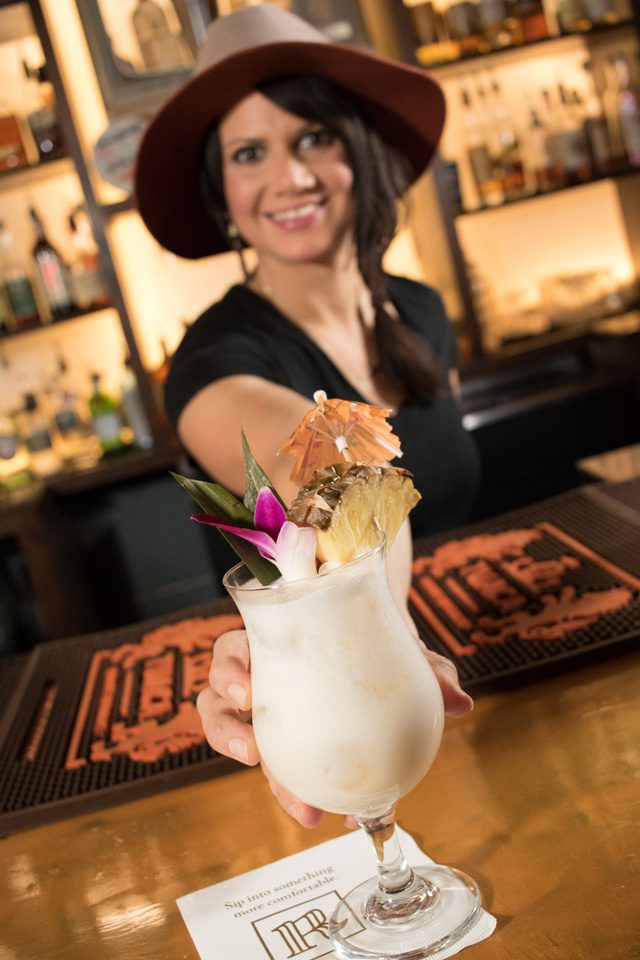
Mains had worked at restaurants while in college, but it wasn’t until she moved to Oklahoma City and began bartending at in the raw that she started on her current trajectory. When the owners wanted to sell the location, she and her husband purchased it and rebranded it as DEKORA!
While the performance of DEKORA! led to new projects, Mains didn’t become interested in creating a cocktail-focused bar until she was staying home after having her first child.
[pullquote]
Pina Colada
- 1.5 oz pineapple infused Cana Brava Rum
- 0.5 oz Cointreau
- 0.75 oz pineapple juice
- 0.5 oz lime juice
- 1 oz Coco Lopez or sweetened coconut milk
- 1 egg
- 2 dashes orange flower water
- Shake hard and dump into hurricane glass. Garnish with pineapple, pineapple fronds and an umbrella.
[/pullquote]
“I enjoyed a cocktail, but it kind of seemed like something to me that was cool, but not anything that was applicable to what we would see in Oklahoma,” she says. “All of a sudden, especially in the first couple of months, I was at home a lot and started reading all the cocktail books, and it kind of grabbed me. I realized it was something I wanted to learn more about, and I really wanted to be able to take all these things that were going on across the nation and bring some of the fun cocktails to Oklahoma City.”
From there, Mains conceptualized and founded Rockford Cocktail Den, which provides those types of cocktails in a relaxed environment. She is also working with Proprietors LLC, the group responsible for high-profile cocktail bars such as Death & Co. and Nitecap in New York and Honeycut in Los Angeles, on a new project in Oklahoma City.
Mains is excited about the new project, but she says it will probably be her last for a while because she has realized how much she enjoys working behind the bar.
“In my eyes, we’re kind of in the entertainment industry,” she says. “I am a horrible actor. I am a horrible singer. I can’t entertain people that way, but I can make sure that when you come into my house, my bar, I’m going to throw you a heck of a party, and I’m going to make sure I go above and beyond to treat you special and make sure you’re going to enjoy your time there.”
A Taste for the Classics
Dressed in a tie, herringbone vest and pinstriped pants, Jamie Jennings looks exactly like the person to teach others about classic cocktails.
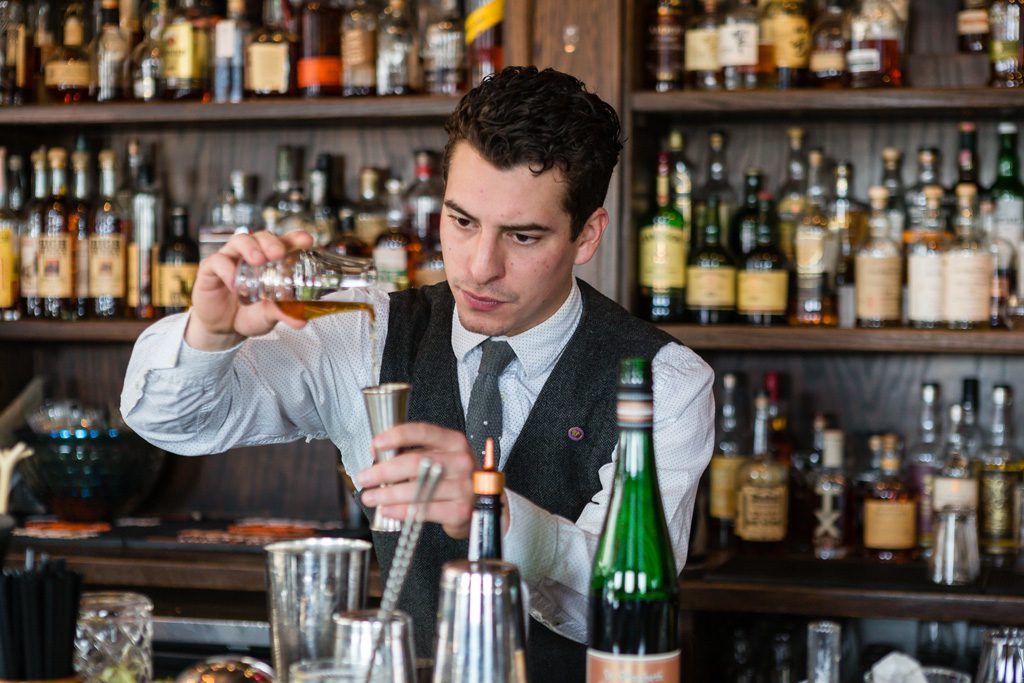
“People have been drinking for so long, everything has been made,” says Jennings, bar manager at Hodges Bend in downtown Tulsa. “All these crazy drinks people are making these days are based on some historical drink. So if you can understand the history and the past, then you’re set.”
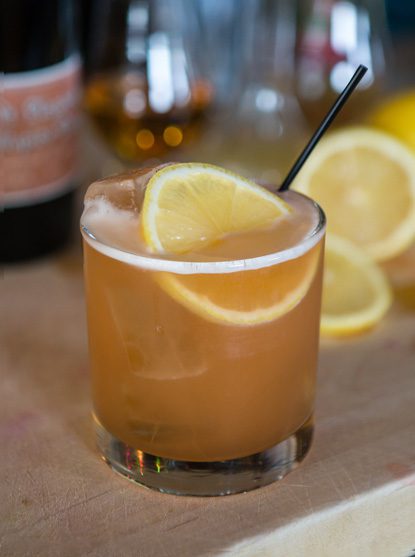 [pullquote]
[pullquote]
Lion’s Tail
- 2 oz bourbon
- 0.75 oz fresh lemon juice
- 0.5 oz St. Elizabeth Allspice Dram (liqueur)
- 2 tsp Gomme syrup (2:1 Simple syrup is an acceptable substitute)
- 1 dash Angostura bitters
- Shake and strain over ice in a rocks glass.
Garnish with lemon wheel.
[/pullquote]
While Hodges Bend doesn’t ignore signature drinks (Jennings estimates the bar has created 50 or 60 signature drinks since the business opened in 2014), the focus on classic drinks helps guide what’s available to the customer. All employees at Hodges are taught how to make classics before trying anything original.
Jennings’s search for inspiration for drinks goes beyond the classics, and he actively seeks new recipes to study and try.
“With today’s technology, I have access to a lot of stuff that has been scanned into libraries and books dating back to the 1870s and 1880s, and we have a pretty solid library here at Hodges that we can go to,” he says. “I have a lot of really good, regular customers who will bring us old books that they have found and let us work through them before we give them back. I’m always reading old literature, especially based on bartending.
“I think we take this very seriously, and people don’t always realize that. This is a serious thing. Bartending is not going anywhere, and we want to specialize in it, so we do take our time to study.”
Jennings started his career as a hotel bellman who started cleaning and setting tables because he wanted to watch football games in the bar. That turned into an offer to bartend, and he worked at several different taverns before landing at Hodges Bend.
While he enjoys working behind the bar, he says he doesn’t anticipate remaining a bartender and sees himself perhaps in the kitchen at some point. He enjoys working with food for the same reason he enjoys mixology.
“I love it because, in the end, a good bartender understands balance and so does a good chef,” he says. “It’s about balancing your citrus, your spirit, your sweet and your bitter, and it’s the same thing in the kitchen. I think they have a lot of commonalities, and it’s all about balance at the end.”
A Bartender and Sommelier
While Lesley Nelson, bar manager at Torero, may be skilled at crafting cocktails, she’s at least equally proud of her unofficial title of “Tulsa’s Youngest, Hottest Sommelier.”
“I’ve held that title for almost three years,” she says with a laugh.
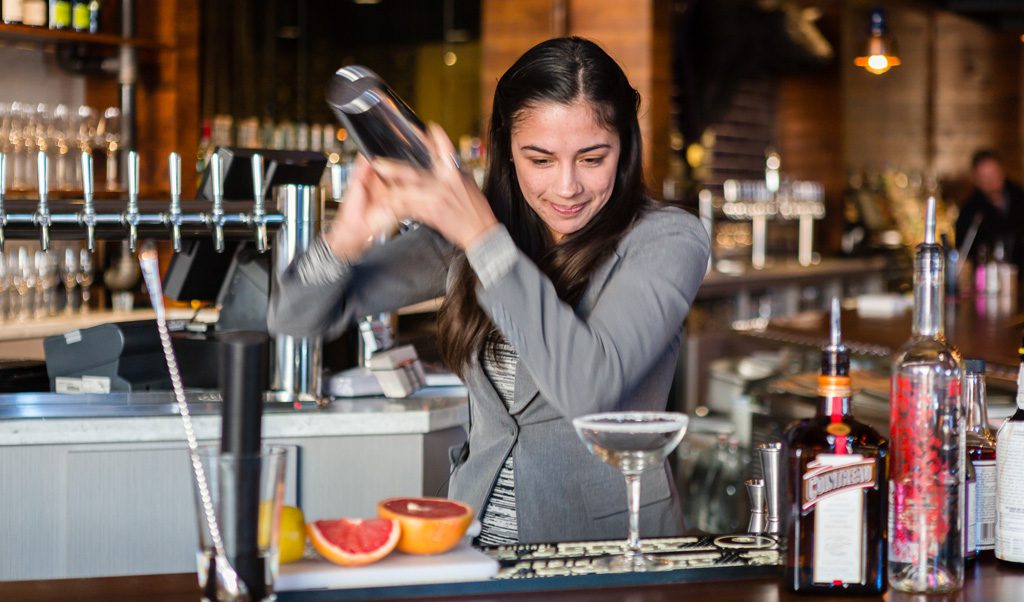
While Nelson has developed many skills, she says wine was her first passion. Starting as a server for a chain steakhouse, she moved behind the counter and worked at a wine bar before stints at Hodges Bend and Saturn Room, which led to her new position at Torero. In addition to serving as bar manager, she is certified with the Guild of Sommeliers and helps customers pick out wines as well as creating the wine list and educating the staff on the subject.
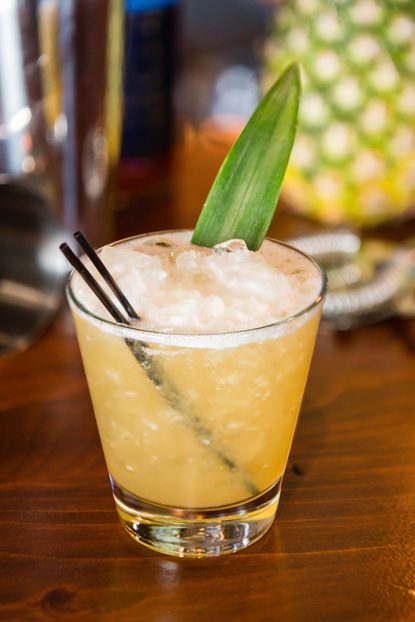 Nelson is also a certified specialist of wine with the Society of Wine Educators, a different organization that focuses on knowledge and standards instead of service.
Nelson is also a certified specialist of wine with the Society of Wine Educators, a different organization that focuses on knowledge and standards instead of service.
[pullquote]
Zozobrara
- 1.5 oz rum (blend of tobacco infused Brugal Anejo, Hamilton Saint Lucia and Smith & Cross)
- 0.75 oz lime juice
- 0.75 oz pineapple juice
- 0.75 oz grilled pineapple syrup
Shake and strain over crushed ice in a rocks glass. Add more ice and garnish with a pineapple leaf.
[/pullquote]Though wine may have been her first love, she developed an equal passion for mixology.
“Bartending just came really natural to me,” she says. “I was good at memorizing drinks, and I liked it a lot.”
Like many other bartenders focused on mastering the craft, she studies classic drinks, reads anything she can get her hands on and tries mixing drinks from classic recipes, though she admits the results sometimes require some work.
“I’ll see a cocktail that’s something I’ve never seen before,” she says. “Some crazy, obscure recipe, and I’ll try to make it good. And usually they’re not that good, and that’s where I’ll tweak them and make them good.”
Nelson says she enjoys working behind the bar, and appreciates the respect the profession is given as more interest is being given to craft cocktails. That increased interest helps push her to improve.
“People consider bartending a career now,” she says. “All over the U.S., there are career bartenders, basically. There is a lot that goes into it if you want to be good, and even the consumers now know a whole lot more about what everybody’s serving now. You’ve got to be able to know what you’re doing to impress customers or get them interested in what you’re doing.”
The Accidental Bartender
Chris Barrett didn’t intend to become a bartender. Originally, he was hired to wait tables at a restaurant in Bricktown, but offered to help as a barback because he started work on Valentine’s Day weekend, where the crowds made going through training difficult.

He did a good enough job as a barback that the owner asked him to fill an open position as a bartender – but that doesn’t mean his start behind the bar was completely smooth.
“I remember on the first day of training, the owner overheard the bartender teaching me the most basic of things (I think it was how to make a martini), and he asked me if I had ever bartended before,” Barrett says. “When I said no, he got this [panicked] look on his face then said reluctantly, ‘Well I guess you gotta learn somewhere.’ I did learn, and I’ve been bartending ever since.”
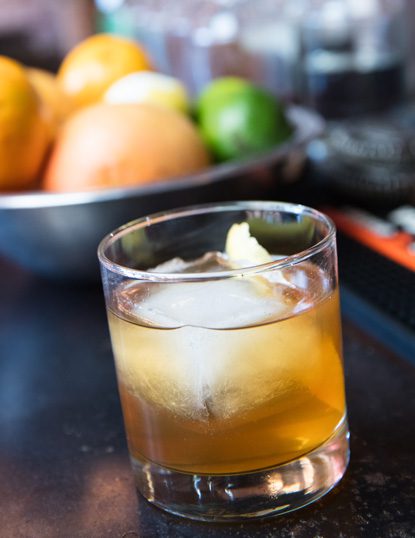 [pullquote]
[pullquote]
Scotch Yer Nose
- 1.5 oz. blended Scotch
- 0.75 oz. Pedro Ximinez sherry
- 0.5 oz. lemon juice
- 0.5 oz. honey syrup
- 3-4 basil leaves
- 2 dashes aromatic bitters
In a shaker, muddle the basil with the honey syrup. Add the remaining ingredients and shake with ice. Double strain into a coupe glass and garnish with a basil leaf.
[/pullquote]
Twelve years later, Barrett still hasn’t stopped. Now serving as bar manager and head bartender at Ludivine, he’s long past learning how to make basic drinks and creates his own.
His methods for working on a new creation vary – sometimes he starts with a spirit he likes and tries to create a drink to highlight its features, and sometimes he starts with one of the non-alcoholic ingredients. Either way, he says he goes back to the classic cocktails, considering how and why they work.
“Most recently, though, we’ve been developing concept cocktail menus at Ludivine,” he says. “We start with a concept, then decide on the names of the cocktails that fit that concept and then create a drink that, to us, fits the name. It’s working backward from a name to a cocktail.”
Barrett doesn’t see the cocktail resurgence as anything truly new and compares it with other skills you’d find in a restaurant.
“The word ‘mixologist’ dates back to the 1800s when creating drinks was a highly respected craft,” he says. “But I tend to agree with Anthony Bourdain’s view of cooking being more of a craft than an art. Cooking, mixology and bartending are crafts with immense room for creativity.”
Barrett’s favorite cocktails run to the classics: the Martinez, The Last Word and the Vieux Carre. At home, he says he’s more likely to drink straight liquor or something simple, such as a Manhattan, martini or Negroni. If he has guests, though, he’ll make something fun for them.
“But I don’t drink much at home anyway,” he says. “I’d rather go to a bar.”






















